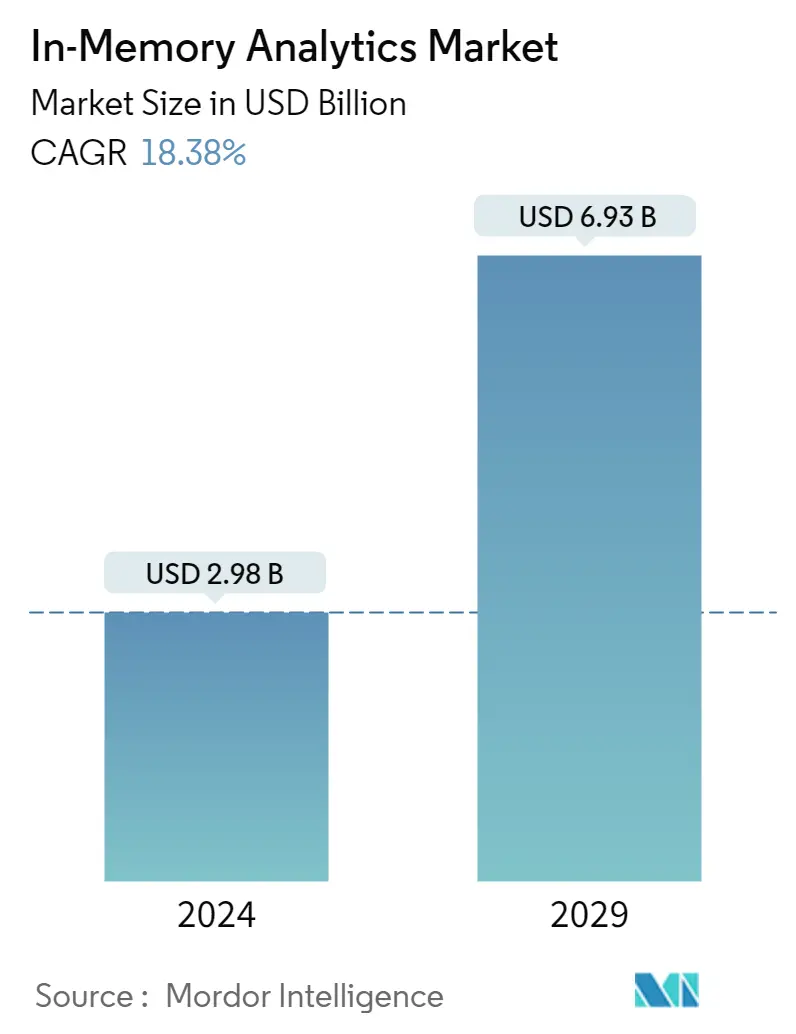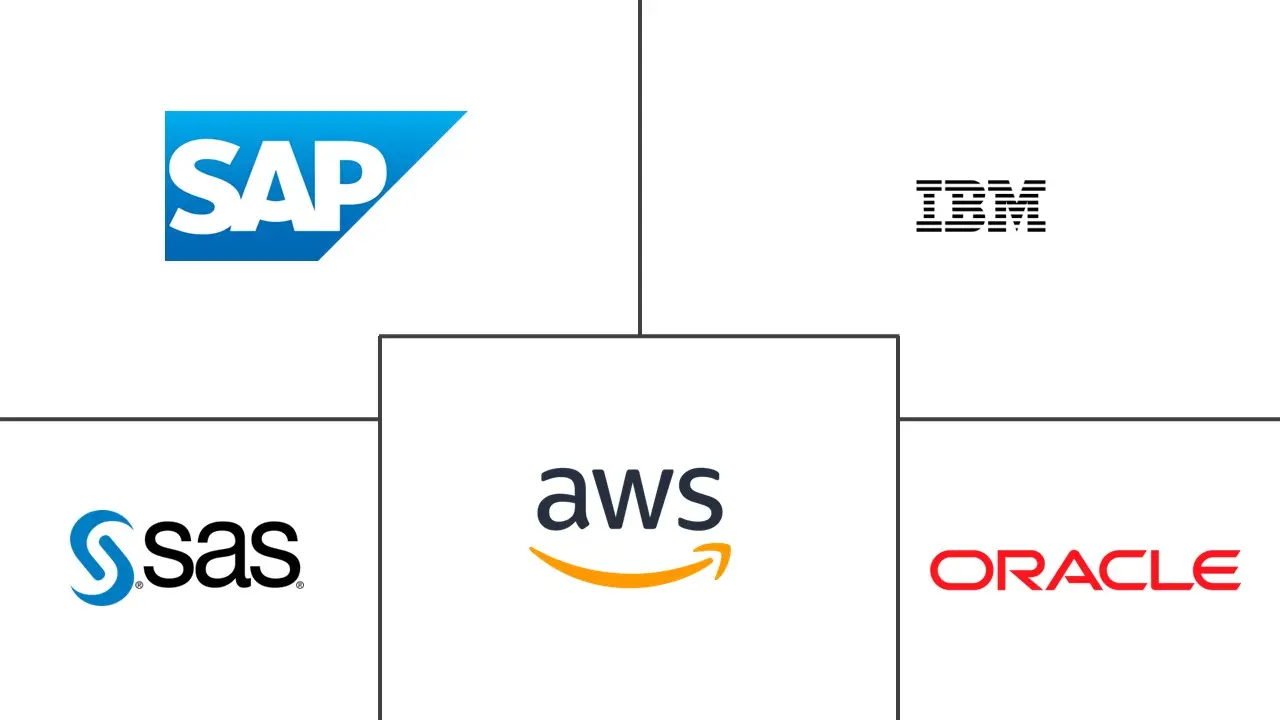Market Size of In-Memory Analytics Industry

| Study Period | 2019 - 2029 |
| Market Size (2024) | USD 2.98 Billion |
| Market Size (2029) | USD 6.93 Billion |
| CAGR (2024 - 2029) | 18.38 % |
| Fastest Growing Market | Asia Pacific |
| Largest Market | North America |
Major Players
*Disclaimer: Major Players sorted in no particular order |
In-Memory Analytics Market Analysis
The In-Memory Analytics Market size is estimated at USD 2.98 billion in 2024, and is expected to reach USD 6.93 billion by 2029, growing at a CAGR of 18.38% during the forecast period (2024-2029).
New persistent memory technologies will help reduce the costs and complexity of adopting BMI-enabled architectures (in-memory computing), which is becoming a trend nowadays. Persistent memory represents a new layer of memory between the DRAM and NAND flash memory, which can provide economical mass memory for high-performance workloads. This option can improve application performance, availability, boot times, load methods, and security practices while controlling costs.
- Digital transformation across all major industries leads to the adoption of real-time analytics as technology trends such as hyper-connectivity, cloud computing, and big data go hand-in-hand with social and business trends. It will enable enterprises to start implementing hybrid transactional/analytical processing (HTAP) strategies, which have the potential to revolutionize data processing by providing real-time insights into big data sets while simultaneously driving down costs.
- The continuously growing volumes of data worldwide create demand for analytics solutions to store, easily access, and analyze this data to generate meaningful insights and make business decisions. In-memory analytics helps organizations overcome the challenges of big data as it is stored in memory that boosts speed and minimizes latency. The emerging technologies further contribute to growing data volume.
- The metaverse, virtual reality, augmented reality, and other emerging technologies are gaining traction nowadays and are expected to further create huge amounts of structured and unstructured data, projected to create demand for in-memory analytics solutions. The growing proliferation of wearables. Smart devices and the Internet of Things fuel the market growth. For instance, according to Cisco, the growth in connected wearable devices, which was forecasted to reach 1,105 million devices in 2022, also contributes to the growing volume of data.
- However, the lack of awareness about the product and higher penetration of conventional analytics tools is restraining the market growth. In-memory may not immediately produce the results; one should desire simply by swapping out technologies and architecture. It requires skills and expertise to manage what's happening, which is profoundly lacking.
- The outbreak of the COVID-19 pandemic accelerated the adoption of digital technologies across all industries and created a huge amount of data which drove the demand for analytics solutions. The increased adoption of AR/VR and smart devices in healthcare due to the COVID-19 pandemic also accelerated the demand for analytics solutions to make data-driven decisions. The successful implementation of such solutions will likely encourage more vendors and businesses to adopt in-memory analytics solutions, paving the way for the studied market's growth during the forecast period.
In-Memory Analytics Industry Segmentation
In-memory analytics methodology helps in solving complex and time-sensitive business scenarios. It has not only emerged as a faster and more affordable solution, but it also facilitates organizations in integrating information and presents a holistic view of the situation, powered by real-time data that strengthens the decision-making process.
The In-Memory Analytics Market is segmented by Deployment (On-premise, Cloud), End-user Industry (BFSI, Retail, IT & Telecommunication, Manufacturing, Government), and Geography (North America, Europe, Asia-Pacific, and Middle East & Africa). The market sizes and forecasts are provided in terms of value (USD) for all the above segments.
| By Deployment | |
| On-Premise | |
| Cloud |
| By End-user Industry | |
| BFSI | |
| Retail | |
| IT and Telecommunications | |
| Manufacturing | |
| Government and Public Sector | |
| Other End-user Industries |
| By Geography | |
| North America | |
| Europe | |
| Asia-Pacific | |
| Latin America | |
| Middle East & Africa |
In-Memory Analytics Market Size Summary
The in-memory analytics market is poised for significant growth, driven by the increasing need for real-time data processing and insights across various industries. The adoption of persistent memory technologies is reducing the costs and complexities associated with in-memory computing architectures, making them more accessible. This trend is further fueled by the digital transformation initiatives across sectors, where technologies like hyper-connectivity, cloud computing, and big data are becoming integral. These advancements enable enterprises to implement hybrid transactional/analytical processing strategies, offering real-time insights into large data sets while optimizing costs. The proliferation of emerging technologies such as the metaverse, virtual reality, and the Internet of Things is generating vast amounts of structured and unstructured data, thereby boosting the demand for in-memory analytics solutions.
The manufacturing sector is expected to be a significant contributor to the market's expansion, with Industry 4.0 and technological advancements enhancing operational efficiencies. In-memory analytics is increasingly utilized to improve manufacturing quality, reduce costs, and enhance supply chain capabilities. The Asia-Pacific region, particularly China and India, is witnessing rapid growth due to the digitization of end-users and the adoption of cost-effective cloud-based analytical software by small and medium-sized businesses. Government initiatives and the expansion of mobile technology further propel market growth in this region. The competitive landscape is marked by the presence of key players like SAP SE, IBM Corporation, and Oracle Corporation, who are continuously innovating and expanding their product offerings to maintain market share and meet the evolving needs of businesses.
In-Memory Analytics Market Size - Table of Contents
-
1. MARKET INSIGHTS
-
1.1 Market Overview
-
1.2 Industry Value Chain Analysis
-
1.3 Industry Attractiveness - Porter's Five Forces Analysis
-
1.3.1 Bargaining Power of Buyers/Consumers
-
1.3.2 Bargaining Power of Suppliers
-
1.3.3 Threat of New Entrants
-
1.3.4 Threat of Substitute Products
-
1.3.5 Intensity of Competitive Rivalry
-
-
-
2. MARKET SEGMENTATION
-
2.1 By Deployment
-
2.1.1 On-Premise
-
2.1.2 Cloud
-
-
2.2 By End-user Industry
-
2.2.1 BFSI
-
2.2.2 Retail
-
2.2.3 IT and Telecommunications
-
2.2.4 Manufacturing
-
2.2.5 Government and Public Sector
-
2.2.6 Other End-user Industries
-
-
2.3 By Geography
-
2.3.1 North America
-
2.3.2 Europe
-
2.3.3 Asia-Pacific
-
2.3.4 Latin America
-
2.3.5 Middle East & Africa
-
-
In-Memory Analytics Market Size FAQs
How big is the In-Memory Analytics Market?
The In-Memory Analytics Market size is expected to reach USD 2.98 billion in 2024 and grow at a CAGR of 18.38% to reach USD 6.93 billion by 2029.
What is the current In-Memory Analytics Market size?
In 2024, the In-Memory Analytics Market size is expected to reach USD 2.98 billion.

